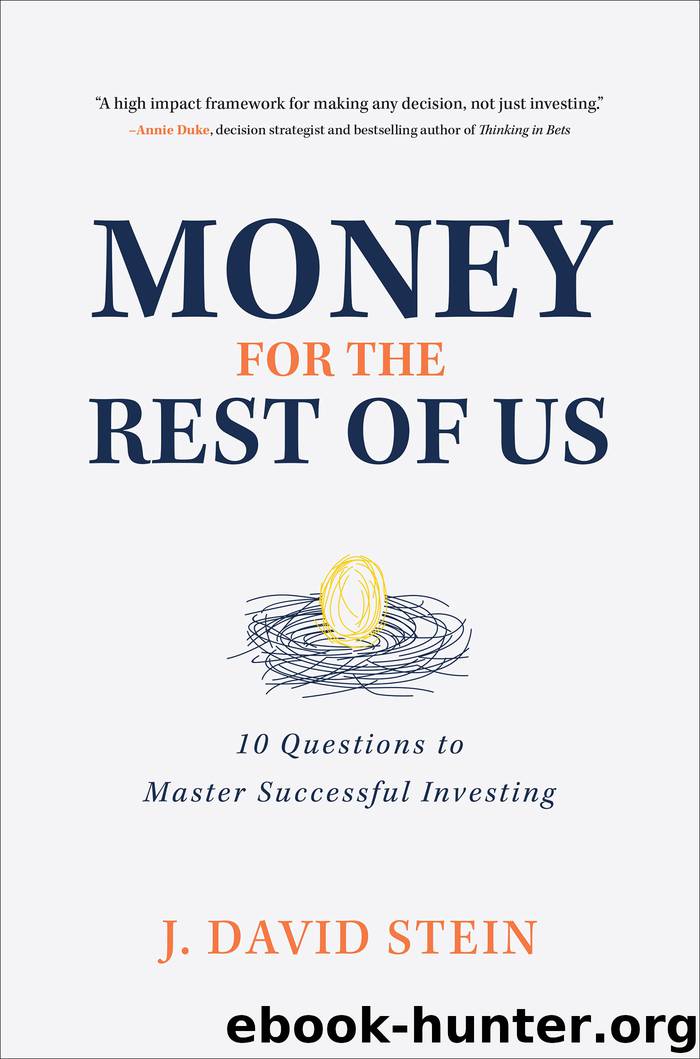Money for the Rest of Us by J. David Stein

Author:J. David Stein
Language: eng
Format: epub
Publisher: McGraw-Hill Education
Published: 2020-10-28T16:00:00+00:00
RETURN DRIVERS
As we discussed earlier, three drivers determine the return for most investments (as opposed to speculations):
1. CASH FLOW. The income from interest, dividends, or rents that is distributed to the asset owner
2. CASH FLOW GROWTH. How the income stream or cash flow grows over time
3. CHANGE IN VALUATION. What investors are willing to pay for the income stream now versus later
These return drivers explain why investments have positive expected returns. The simplest way to harvest those returns is through the use of index mutual funds or ETFs. These passive investment vehicles allow us to purchase baskets of individual securities without having to worry whether a specific underlying holding is priced correctly in that its market price equals its intrinsic value. Recall that intrinsic value, also known as the present value, is the price in today’s dollar of an investment’s future income stream, such as dividends or interest.
An alternative to buying index funds or passive ETFs is to seek to identify securities where the market price is less than its intrinsic value. This adds another layer of complexity to successful investing, as we are no longer just harvesting the returns of the overall market. Instead, we are seeking to earn excess returns through security selection because we believe that the market price is wrong, that the consensus of investors is incorrect. Howard Marks, author and co-chairman of Oaktree Capital, wrote: “All investors who follow a given asset have (or should have) opinions regarding its intrinsic value. The market price of the asset reflects the consensus of those opinions, meaning investors collectively have set the price. That’s where buyers and sellers agree to transact. The buyers buy because they think it’s a smart investment at the current price, and the sellers sell because they think it’s fully priced or overpriced there.”6
There is no doubt prices of individual securities are not always correct. The price of a security does not always reflect its intrinsic value. The question is do we have the skill to identify those mispriced securities? Are we smarter than other investors? Most professional investors fail to outperform the market, but some do, as do some individuals. But harvesting those excess returns requires us to be precisely right in order to be successful.
Andrea, a listener to my podcast, wrote me:
One thing I’ve heard you say on the podcast and many other times, is “the only reason to buy an individual stock is if you believe that the market is wrong.” I’m wondering if you really think that? I’m asking this because I can think of lots of reasons to buy individual stocks, such as having control of taxable events, finding and investing in a product/company that I really like a lot, avoiding mutual fund/ETF expenses, wanting to have a good dividend that you can’t normally find in an ETF or mutual fund, and then sometimes just wanting to have a little “mad money” to play around with.7
I agree with Andrea that it is fun to play around by buying individual
Download
This site does not store any files on its server. We only index and link to content provided by other sites. Please contact the content providers to delete copyright contents if any and email us, we'll remove relevant links or contents immediately.
| Analysis & Strategy | Bonds |
| Commodities | Derivatives |
| Futures | Introduction |
| Mutual Funds | Online Trading |
| Options | Portfolio Management |
| Real Estate | Stocks |
Rich Dad Poor Dad by Robert T. Kiyosaki(6399)
Pioneering Portfolio Management by David F. Swensen(6226)
How To Win Friends and Influence People by Dale Carnegie(4442)
The Money Culture by Michael Lewis(4076)
The Dhandho Investor by Mohnish Pabrai(3698)
The Wisdom of Finance by Mihir Desai(3650)
Liar's Poker by Michael Lewis(3367)
Fooled by Randomness: The Hidden Role of Chance in Life and in the Markets by Nassim Nicholas Taleb(3043)
The ONE Thing by Gary Keller(3007)
The Intelligent Investor by Benjamin Graham Jason Zweig(2995)
Mastering Bitcoin: Programming the Open Blockchain by Andreas M. Antonopoulos(2980)
How to Day Trade for a Living: Tools, Tactics, Money Management, Discipline and Trading Psychology by Andrew Aziz(2909)
Rich Dad Poor Dad: What The Rich Teach Their Kids About Money - That The Poor And Middle Class Do Not! by Robert T. Kiyosaki(2907)
Investing For Dummies by Eric Tyson(2894)
How to Win Friends and Influence People by Dale Carnegie(2861)
Market Wizards by Jack D. Schwager(2643)
Zero Hour by Harry S. Dent Jr. & Andrew Pancholi(2614)
How to Pay Zero Taxes, 2018 by Jeff A. Schnepper(2592)
The Psychology of Money by Morgan Housel(2591)
